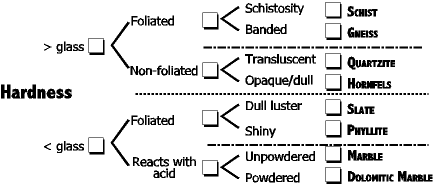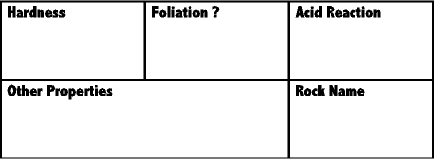Simple Metamorphic Identifiction
Keys and Charts
Keys and Charts
The heart of science is the ability to make accurate observations about the natural world. Therefore, one of the things students must learn is how to make systematic observations, and then logically use those observations to classify things.
From my point of view, it is this skill of observation, decision making, and narrowing of possibilities to the right one that is the most important thing students should learn. This page provides some suggestions and materials for doing that.
A note about needed materials. Two of the most common properties we measure are hardness and reaction with dilute hydrochloric acid. It is very difficult to avoid these two tests - although sometimes we can just tell the students what these properties are, or have a small group do the test and tell the others. If these tests are new to you, go to Hardness and Acid Reaction Tests for suggestions.
Rocks are identified by making a series of decisions about their properties, such as texture, composition, hardness, etc. This requires the ability to observe and recognize these properties.
The Key to Common Metamorphic Rocks allows someone to identify a rock based on its properties. We are able to do this because the properties do not overlap completely. You can see this on the key through the color coding for the properties. None of the colors overlap completely. [Note this key does print legibly in black and white.]
For example, the key has eight rocks; four of these scratch glass and four do not, so immediately we can divide the rocks into two categories. But also notice that four of the rocks are foliated, and of these two are harder than glass and two softer than glass. Thus, if we have a foliated rock harder than glass it can only be one of two rocks - schist or gneiss. And we distinguish them on their texture.
In similar ways by observing a few properties of a rock we can quickly narrow its identification down to a few, and then with further information in the key, to one choice. Voila !, we have it identified. It is not unusual for most rocks to be identified with two, or sometimes three, observed properties (as long as they are the right ones!), so once we know how to do it identification is quick and accurate.
The key is the simplest way to go, and with a little practice anyone should be able to use it. For students new to this, however, learning to think systematically and logically is a skill that still has to be perfected. For this purpose we use various charts, diagrams, and data tables. These are limited only by the imagination, but several types are provided here if you want them.
 Observation Chart One
Observation Chart One
This chart leads a person systematically through a series of observations and decisions. Its organization is extracted directly from the key, and if done correctly will lead a person to the single correct identification.
(Click on picture for a full page version - pdf version).
 Observation Chart Two
This chart does not have as many forks in it (i.e. dichotomous decisions) and at the end requires returning to the key for descriptions to make the final decision. It will connect better the use of the observation chart and the key.
Observation Chart Two
This chart does not have as many forks in it (i.e. dichotomous decisions) and at the end requires returning to the key for descriptions to make the final decision. It will connect better the use of the observation chart and the key.(Click on picture for a full page version - pdf version).
 Observation Chart Three
Observation Chart ThreeJust a variation on chart two.
(Click on picture for a full page version - pdf version).
 Observation Chart Four
Or. if you just want a table with spaces for students to write down their observations before going to the key to identify it, this chart will do that.
Observation Chart Four
Or. if you just want a table with spaces for students to write down their observations before going to the key to identify it, this chart will do that.(Click on picture for a full page version - pdf version).
 Observation Chart Five
Or, it you want a more complex and sophisticated observation table, use this one.
Observation Chart Five
Or, it you want a more complex and sophisticated observation table, use this one.(Click on picture for a full page version - pdf version).
Return to:
Other pages associated with this page:
Go on to: